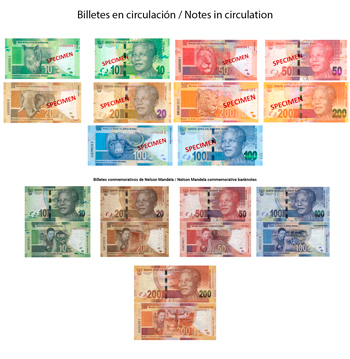South African rand exchange rate
WE SELL RATE HISTORY OF SOUTH AFRICAN RAND
WE BUY RATE HISTORY OF SOUTH AFRICAN RAND
SOUTH AFRICAN RAND INFO
The South African Rand is the official currency of South Africa. It is also legal tender in countries like Lesotho and Namibia.
Notes: 10, 20, 50, 100, 200
Coins: 10, 20, 50 cent and 1, 2, 5 rand
Subunit: Cent
Code: ZAR
Symbol: R
Main Exchanges
If you are going to visit Johannesburg, Cape Town or any other city of South Africa you will need to exchange your Euros to South African Rands. In Eurochange you can buy your South African Rands at the best price and with total availability. Buy them now online or find the nearest exchange office with the service to buy currencies.
About South African Rand
The Rand is the official currency of South Africa, Swaziland and Lesotho (which form a common currency space) and although Namibia is separated from this union, the Rand remains legal tender there. Its ISO code 7214 is ZAR and is represented by "R" symbol. Each Rand is divided into 100 cents.
History of the currency of South Africa
It was introduced in 1961, the same year that the Republic of South Africa was proclaimed to replace the South African Pound. In the beginning, it had a higher value than the dollar, but suffered a major devaluation and has not come to be equated to its value at the time.
Its name is due to Witwatersrand, the mountain on which the city of Johannesburg is located. Popularly it is also known as Rand and it is one of the main regions of the world in gold mining (it is estimated that 40% of the world's gold has been extracted there).
Notes and coins of South African Rand
The South African Rand notes are 10, 20, 50, 100 and 200 Rand.
BANKNOTES OF SOUTH AFRICAN RAND IN CIRCULATION
The image of Nelson Mandela appears on the front of the banknotes. Mandela is one of the South Africans best known worldwide for his political struggle against apartheid and social inequality and for being president of South Africa in the 90s.
On the back of the banknotes appear "the Big Five", which are the rhinoceros, the elephant, the lion, the buffalo and the leopard (they appear in this order in the notes from lowest to highest amount). There are those who erroneously believe that they are known as "the Big Five" because they are the largest mammals in Africa. But it's not correct. The use of the term is because they are considered the most difficult animals to hunt on foot and whose capture is more dangerous.
In addition, the banknotes also show the coat of arms of the country and images of cave paintings depicting hunting scenes. As a background, there are several motifs that emulate the geometric drawings that are used in the typical tribal fabrics of South Africa.
On the front of the banknotes we can see the name of the Reserve Bank of South Africa in English. South Africa is the country with the most official languages, there are 11 in total, and this fact is reflected on the back of the banknotes, where the Bank's name appears in the other ten official languages (two for each note): Afrikaans, Setsuana, Sesoto, Xhosa, Sesoto sa leboa, South Ndebele, Zulu, Venda, Tsonga and Suazi.
In 2018 they introduced a new series in commemoration of the centenary of the birth of Nelson Mandela, who is known as Madiba. On the front we can see the same image as on the notes of the previous series and on the reverse there is an image of a young Nelson Mandela.
The South African Rand coins are 5, 10, 20 and 50 cents and 1, 2 and 5 Rand. In them appear different species of native flora and fauna: the crane of paradise, a cove, a protea king, a flower of paradise, a specimen of jumping gazelle of the Cape, a kudu and a wildebeest.
How many South African Rands should I take to South Africa?
If you are travelling to Cape Town, Johannesburg or any other city in South Africa and do not know how many Rands to take with you, we are the ones to help you. Eurochange customers usually exchange an average of 830 Euros in South African Rands. In order to make an approximate calculation of the money you might need for your trip, take into account whether you have to pay for hotels, car rentals, excursions or entrance fees, or whether you only need to bring money for the daily expenses such as food, public transport or shopping.
Look for the closest office with this currency




